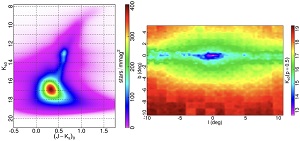- Details
- Published on 22 August 2019
Vol. 629
In section 14. Catalogs and data
Mapping the stellar age of the Milky Way bulge with the VVV. II. Deep JKs catalog release based on PSF photometry
 The Galactic bulge is an old and massive component of the Milky Way that can be resolved into individual stars and so presents a uniquely detailed opportunity to understand how the bulk of the stars in our Galaxy formed and evolved. This provides crucial insight into the formation of all bulges. This paper presents a detailed and comprehensive catalog of the Milky Way bulge stellar population from deep and accurate point spread function fitting photometry of multi-epoch J and K_s images coming from the VISTA Variables in the Via Lactea (VVV) survey of the inner ~300 deg^2 of the Galaxy. The resulting photometric database contains nearly 600 million stars, typically extending down to stars ~1–2 mag below the oldest main sequence turnoff, except along the plane where extinction makes the limit brighter. Examples of possible applications are provided to demonstrate the tremendous potential inherent to this new dataset, including (i) star count studies through the dataset completeness map, (ii) surface brightness map, and (iii) cross-correlation with Gaia Data Release 2. This database is an invaluable collection for the whole community. All the photometric catalogs, including completeness information, are publicly available through the ESO Science Archive as part of the MW-BULGE-PSPHOT release.
The Galactic bulge is an old and massive component of the Milky Way that can be resolved into individual stars and so presents a uniquely detailed opportunity to understand how the bulk of the stars in our Galaxy formed and evolved. This provides crucial insight into the formation of all bulges. This paper presents a detailed and comprehensive catalog of the Milky Way bulge stellar population from deep and accurate point spread function fitting photometry of multi-epoch J and K_s images coming from the VISTA Variables in the Via Lactea (VVV) survey of the inner ~300 deg^2 of the Galaxy. The resulting photometric database contains nearly 600 million stars, typically extending down to stars ~1–2 mag below the oldest main sequence turnoff, except along the plane where extinction makes the limit brighter. Examples of possible applications are provided to demonstrate the tremendous potential inherent to this new dataset, including (i) star count studies through the dataset completeness map, (ii) surface brightness map, and (iii) cross-correlation with Gaia Data Release 2. This database is an invaluable collection for the whole community. All the photometric catalogs, including completeness information, are publicly available through the ESO Science Archive as part of the MW-BULGE-PSPHOT release.


